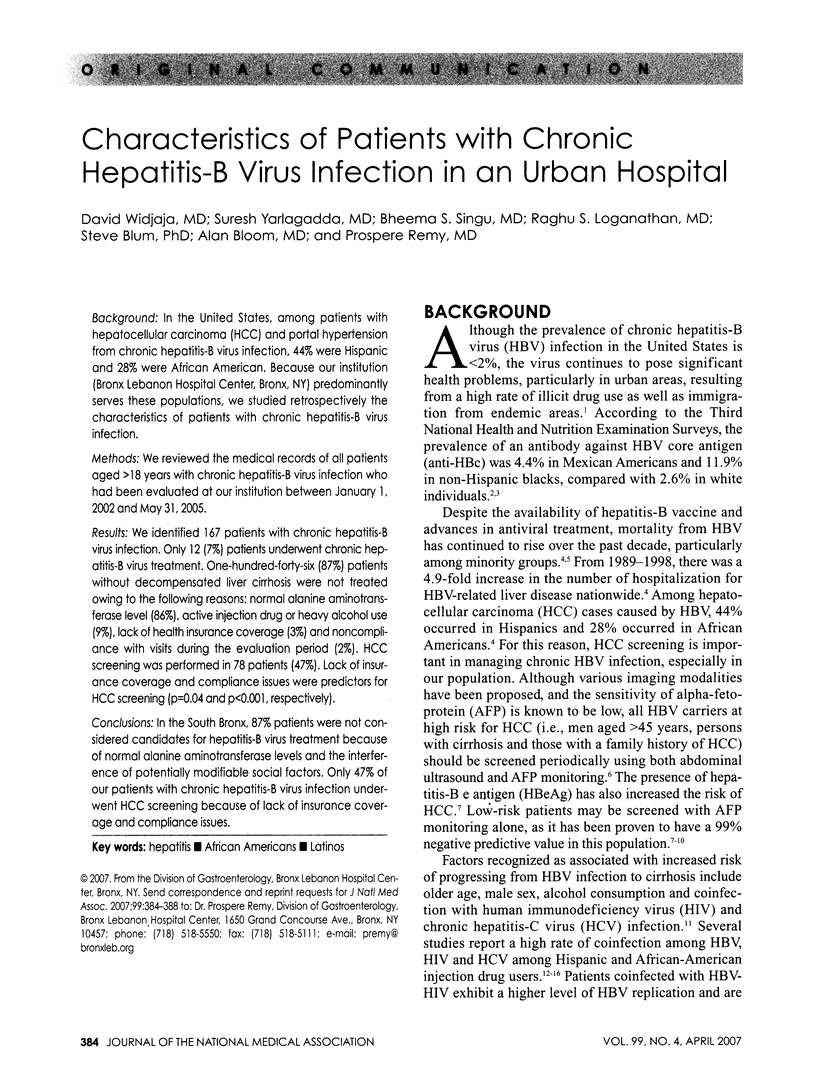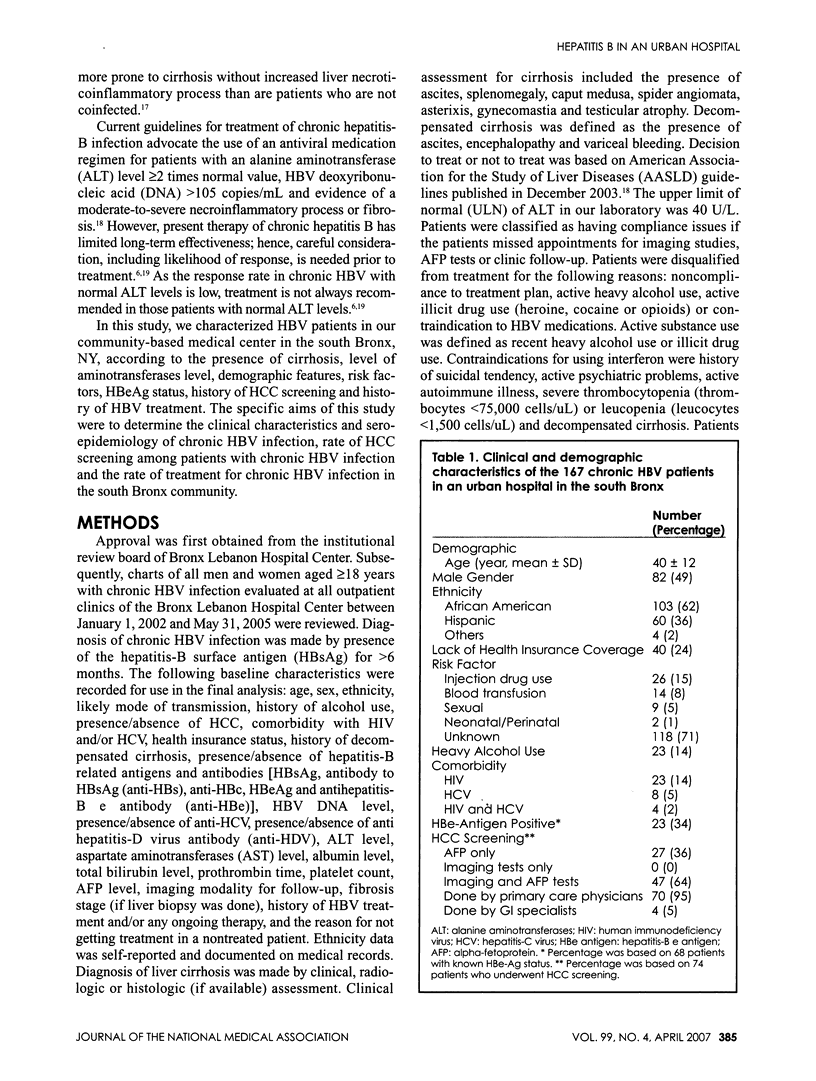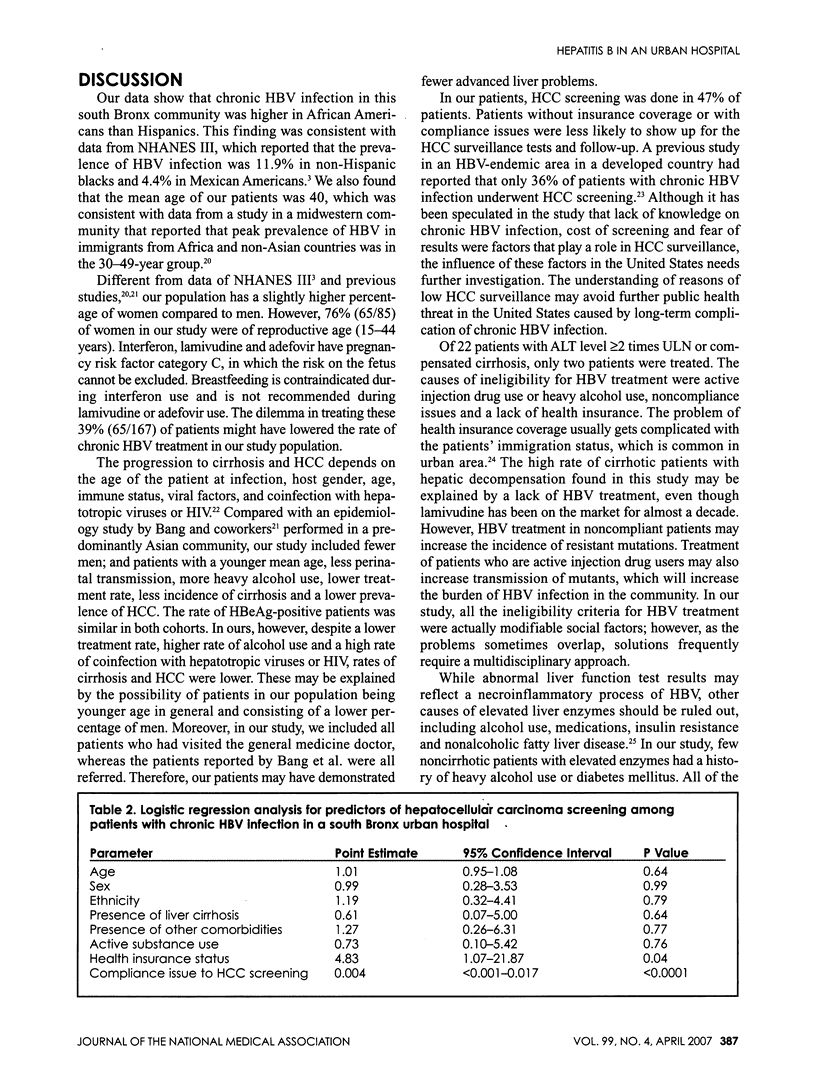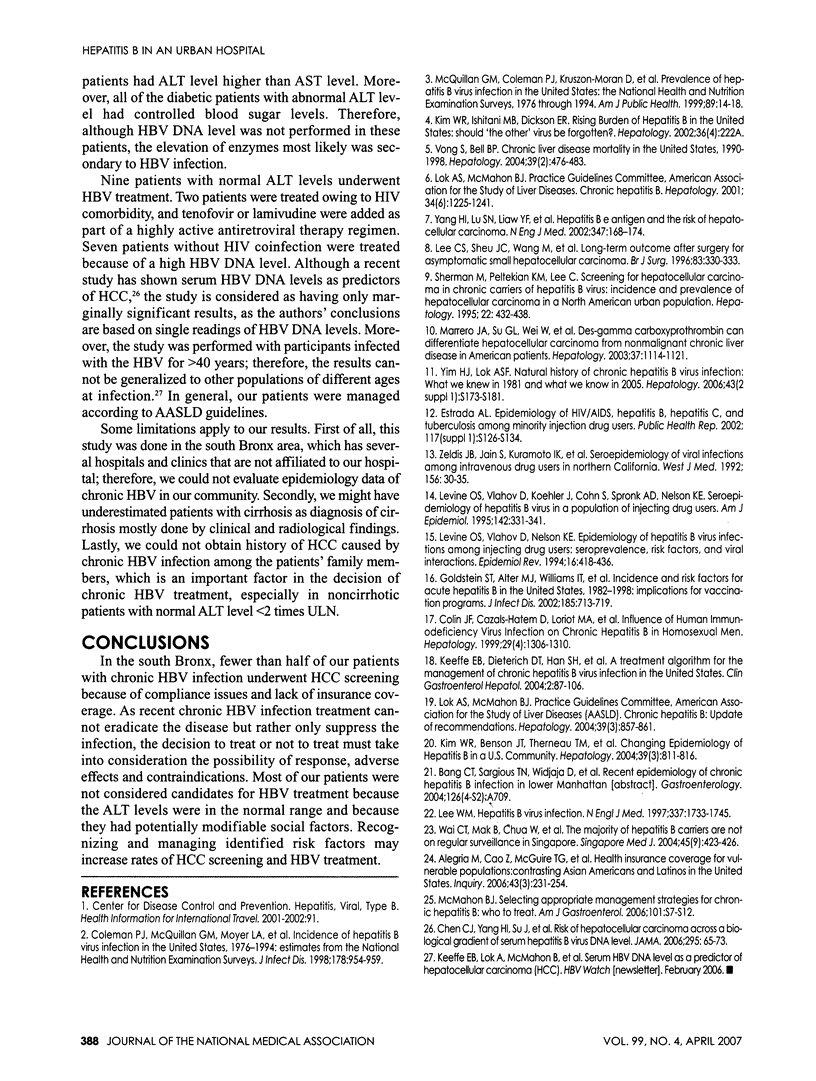Abstract
BACKGROUND: In the United States, among patients with hepatocellular carcinoma (HCC) and portal hypertension from chronic hepatitis-B virus infection, 44% were Hispanic and 28% were African American. Because our institution (Bronx Lebanon Hospital Center, Bronx, NY) predominantly serves these populations, we studied retrospectively the characteristics of patients with chronic hepatitis-B virus infection. METHODS: We reviewed the medical records of all patients aged > 18 years with chronic hepatitis-B virus infection who had been evaluated at our institution between January 1, 2002 and May 31, 2005. RESULTS: We identified 167 patients with chronic hepatitis-B virus infection. Only 12 (7%) patients underwent chronic hepatitis-B virus treatment. One-hundred-forty-six (87%) patients without decompensated liver cirrhosis were not treated owing to the following reasons: normal alanine aminotransferase level (86%), active injection drug or heavy alcohol use (9%), lack of health insurance coverage (3%) and noncompliance with visits during the evaluation period (2%). HCC screening was performed in 78 patients (47%). Lack of insurance coverage and compliance issues were predictors for HCC screening (p = 0.04 and p < 0.001, respectively). CONCLUSIONS: In the South Bronx, 87% patients were not considered candidates for hepatitis-B virus treatment because of normal alanine aminotransferase levels and the interference of potentially modifiable social factors. Only 47% of our patients with chronic hepatitis-B virus infection underwent HCC screening because of lack of insurance coverage and compliance issues.
Full text
PDF




Selected References
These references are in PubMed. This may not be the complete list of references from this article.
- Alegría Margarita, Cao Zhun, McGuire Thomas G., Ojeda Victoria D., Sribney Bill, Woo Meghan, Takeuchi David. Health insurance coverage for vulnerable populations: contrasting Asian Americans and Latinos in the United States. Inquiry. 2006 Fall;43(3):231–254. doi: 10.5034/inquiryjrnl_43.3.231. [DOI] [PMC free article] [PubMed] [Google Scholar]
- Chen Chien-Jen, Yang Hwai-I, Su Jun, Jen Chin-Lan, You San-Lin, Lu Sheng-Nan, Huang Guan-Tarn, Iloeje Uchenna H., REVEAL-HBV Study Group Risk of hepatocellular carcinoma across a biological gradient of serum hepatitis B virus DNA level. JAMA. 2006 Jan 4;295(1):65–73. doi: 10.1001/jama.295.1.65. [DOI] [PubMed] [Google Scholar]
- Choi Jinah, Lee Ki Jeong, Zheng Yanyan, Yamaga Ardath K., Lai Michael M. C., Ou Jing-Hsiung. Reactive oxygen species suppress hepatitis C virus RNA replication in human hepatoma cells. Hepatology. 2004 Jan;39(1):81–89. doi: 10.1002/hep.20001. [DOI] [PubMed] [Google Scholar]
- Coleman P. J., McQuillan G. M., Moyer L. A., Lambert S. B., Margolis H. S. Incidence of hepatitis B virus infection in the United States, 1976-1994: estimates from the National Health and Nutrition Examination Surveys. J Infect Dis. 1998 Oct;178(4):954–959. doi: 10.1086/515696. [DOI] [PubMed] [Google Scholar]
- Goldstein Susan T., Alter Miriam J., Williams Ian T., Moyer Linda A., Judson Franklyn N., Mottram Karen, Fleenor Michael, Ryder Patricia L., Margolis Harold S. Incidence and risk factors for acute hepatitis B in the United States, 1982-1998: implications for vaccination programs. J Infect Dis. 2002 Feb 28;185(6):713–719. doi: 10.1086/339192. [DOI] [PubMed] [Google Scholar]
- Keeffe Emmet B., Dieterich Douglas T., Han Steve-Huy B., Jacobson Ira M., Martin Paul, Schiff Eugene R., Tobias Hillel, Wright Teresa L. A treatment algorithm for the management of chronic hepatitis B virus infection in the United States. Clin Gastroenterol Hepatol. 2004 Feb;2(2):87–106. doi: 10.1016/s1542-3565(03)00312-4. [DOI] [PubMed] [Google Scholar]
- Lee C. S., Sheu J. C., Wang M., Hsu H. C. Long-term outcome after surgery for asymptomatic small hepatocellular carcinoma. Br J Surg. 1996 Mar;83(3):330–333. doi: 10.1002/bjs.1800830310. [DOI] [PubMed] [Google Scholar]
- Lee W. M. Hepatitis B virus infection. N Engl J Med. 1997 Dec 11;337(24):1733–1745. doi: 10.1056/NEJM199712113372406. [DOI] [PubMed] [Google Scholar]
- Levine O. S., Vlahov D., Koehler J., Cohn S., Spronk A. M., Nelson K. E. Seroepidemiology of hepatitis B virus in a population of injecting drug users. Association with drug injection patterns. Am J Epidemiol. 1995 Aug 1;142(3):331–341. doi: 10.1093/oxfordjournals.aje.a117639. [DOI] [PubMed] [Google Scholar]
- Levine O. S., Vlahov D., Nelson K. E. Epidemiology of hepatitis B virus infections among injecting drug users: seroprevalence, risk factors, and viral interactions. Epidemiol Rev. 1994;16(2):418–436. doi: 10.1093/oxfordjournals.epirev.a036161. [DOI] [PubMed] [Google Scholar]
- Lok A. S., McMahon B. J., Practice Guidelines Committee, American Association for the Study of Liver Diseases Chronic hepatitis B. Hepatology. 2001 Dec;34(6):1225–1241. doi: 10.1053/jhep.2001.29401. [DOI] [PubMed] [Google Scholar]
- Marrero Jorge A., Su Grace L., Wei Wei, Emick Dawn, Conjeevaram Hari S., Fontana Robert J., Lok Anna S. Des-gamma carboxyprothrombin can differentiate hepatocellular carcinoma from nonmalignant chronic liver disease in american patients. Hepatology. 2003 May;37(5):1114–1121. doi: 10.1053/jhep.2003.50195. [DOI] [PubMed] [Google Scholar]
- McMahon Brian J. Selecting appropriate management strategies for chronic hepatitis B: who to treat. Am J Gastroenterol. 2006;101 (Suppl 1):S7–12. doi: 10.1111/j.1572-0241.2006.00446.x. [DOI] [PubMed] [Google Scholar]
- McQuillan G. M., Coleman P. J., Kruszon-Moran D., Moyer L. A., Lambert S. B., Margolis H. S. Prevalence of hepatitis B virus infection in the United States: the National Health and Nutrition Examination Surveys, 1976 through 1994. Am J Public Health. 1999 Jan;89(1):14–18. doi: 10.2105/ajph.89.1.14. [DOI] [PMC free article] [PubMed] [Google Scholar]
- Sherman M., Peltekian K. M., Lee C. Screening for hepatocellular carcinoma in chronic carriers of hepatitis B virus: incidence and prevalence of hepatocellular carcinoma in a North American urban population. Hepatology. 1995 Aug;22(2):432–438. [PubMed] [Google Scholar]
- Vong Sirenda, Bell Beth P. Chronic liver disease mortality in the United States, 1990-1998. Hepatology. 2004 Feb;39(2):476–483. doi: 10.1002/hep.20049. [DOI] [PubMed] [Google Scholar]
- Wai C. T., Mak B., Chua W., Lim S. G. The majority of hepatitis B carriers are not on regular surveillance in Singapore. Singapore Med J. 2004 Sep;45(9):423–426. [PubMed] [Google Scholar]
- Yang Hwai-I, Lu Sheng-Nan, Liaw Yun-Fan, You San-Lin, Sun Chien-An, Wang Li-Yu, Hsiao Chuhsing K., Chen Pei-Jer, Chen Ding-Shinn, Chen Chien-Jen. Hepatitis B e antigen and the risk of hepatocellular carcinoma. N Engl J Med. 2002 Jul 18;347(3):168–174. doi: 10.1056/NEJMoa013215. [DOI] [PubMed] [Google Scholar]
- Zeldis J. B., Jain S., Kuramoto I. K., Richards C., Sazama K., Samuels S., Holland P. V., Flynn N. Seroepidemiology of viral infections among intravenous drug users in northern California. West J Med. 1992 Jan;156(1):30–35. [PMC free article] [PubMed] [Google Scholar]


